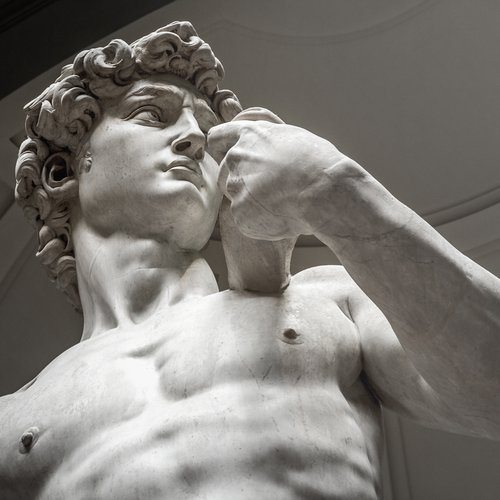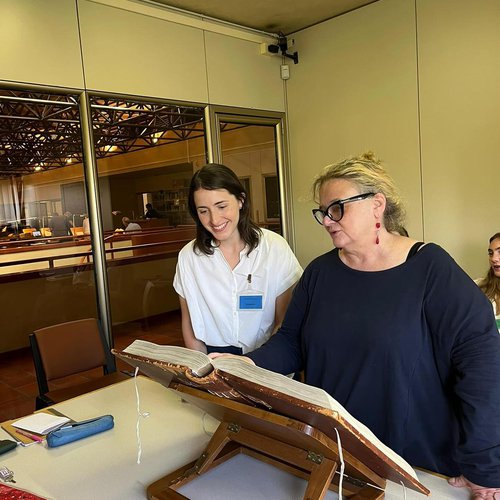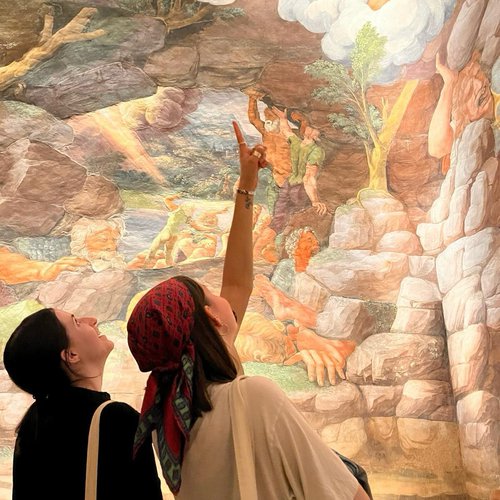Empowering Students to Succeed in Competitive Art Field
Celebrated Florence graduate program marks 60 years of immersive learning in Italy.

For an art historian, it’s hard to find better training than having Florence, Italy, as a classroom for a master’s degree, where you’re immersed in some of the most influential and celebrated art in the world.
This is exactly what you will find in the Florence Graduate Program in Italian Renaissance Art, one of the College of Arts and Sciences’ signature programs.
This world-renowned program provides an M.A. in Art History via an immersive learning experience in Italy to prepare students for the next phase of their career, whether that’s a doctoral degree at a prestigious university, or a leading position in academia, museums, library sciences, art conservation, the tourism industry or marketing and architecture.
Primarily based in Florence, it has gained an international reputation as a premier program, not only due to its prime location, but also through its defining features, including its typically small program size and the rigorous curriculum that gives students the tools and knowledge they need to thrive in their future studies and careers. Florence graduate students network with leading experts and members of the international scholarly community in Florence. It’s also the oldest M.A. art history program accredited in the United States in which most of the study is offered in Italy.
“Students really get their feet wet in art history in a way that is very different from doing a European-focused program in the United States,” says Professor Sally Cornelison, who is the Director of the Florence Graduate Program in Italian Renaissance Art.
“Most students don't get the opportunity to study and do research at the level our program offers until they're in a Ph.D. program.”
Taking the Learning to the Source
This year, the program celebrates its 60th anniversary and will host a pair of events that will showcase the program’s rich history and enduring excellence.
The Florence Program was founded in 1964, by two Syracuse music and art history professors, Abraham Veinus and William Fleming, with the support of Chancellor Tolley, who wanted to create a program abroad that would give graduate students the opportunity to see renowned works of art and architecture in person and to study with leading art conservators and experts in the field.
While the program has evolved over the years, its founders’ spirit remains an integral part of the student experience and the relevance of the Italian Renaissance has not faded over time – nor has the caliber of work from students in the program.
“The Italian Renaissance is a period that holds perennial appeal,” says Cornelison. “You might think that there’s nothing else to say about an artist like Michelangelo, but there's always more to say, and our students are saying those things. Their projects are making real substantive and original contributions to the body of knowledge on the period.”

The Florence Graduate Program has always been defined by the access it provides to Renaissance art and architecture, along with original documents and texts. Florence is home to some of the Renaissance’s most notable works, including Michelangelo’s David and Botticelli’s Birth of Venus. The program’s seminars are led by internationally recognized scholars and conservators, and it offers field study opportunities, as well as numerous occasions to engage with art conservators and museum curators and important archives. It culminates with a symposium at which students publicly present their research.
Florence graduate students undertake individual capstone projects that are one of the program’s most important components. Through these projects, students get to examine Renaissance artworks in person and have access to some of the best libraries in the world for their research, including those at the Kunsthistorisches Institut, Harvard University’s Villa I Tatti and the Biblioteca Nazionale. They also become proficient in archival research and hone their writing and critical thinking skills, in addition to delivering professional-quality public presentations of their original discoveries.

One of the primary goals of the Florence Program is to prepare students to pursue top careers with the skills and knowledge they need to succeed in the field. The small size of the program, which ranges from 6-12 students a year, ensures that professors work closely with each student making for an exceptional intellectual experience and providing training for a variety of art and culture-related fields.
“We attract high caliber students who are very motivated and go on to do extraordinary things, in art history and beyond,” says Cornelison. “Our students are sharp and our program drives them to develop the curiosity and courage to tackle difficult and innovative things.”
Art Conservation is Everywhere in Florence
Isaac Messina ’14, G’17, who now works as an assistant paintings conservator at the Fine Arts Museums of San Francisco, which include the de Young Museum and the Legion of Honor, credits the Florence Graduate Program with helping him to refine the research, writing and presentation skills that have been vital to his studies and career path.
“Prior to treating a painting in my current work, I need to carry out contextual research that helps inform conservation decision-making that is sensitive to original artistic intent and materials,” he explains. “Presenting to a range of audiences is also a core aspect of my job, whether sharing research more formally or giving frequent lab tours to visitors within a wide spectrum of familiarity with the field.”
The Florence Graduate Program also fueled his interest in art conservation and helped to launch his career. He loved getting to experience art and architecture in person, both in Italy and around Europe, and having the city of Florence and the art history library at the Kunsthistorisches Institut as venues to study art conservation.
“Not only does the program include a history of conservation seminar, but also conservation work is so visible during everyday life in Florence–walking by scaffolding in a piazza for the restoration of an outdoor sculpture or in a church for the restoration of a fresco,” he says.

Messina also got to connect with a private paintings conservator based in Florence and assisted her on a large-scale chapel fresco conservation project while he was in Italy.
Some of Messina’s most memorable experiences include an after-hours visit to the Sistine Chapel, visits to the Opificio delle Pietre Dure conservation laboratory, shopping at Zecchi art supplies, and being in Florence for the fiftieth anniversary of the devastating 1966 flood and the unveiling of Giorgio Vasari’s newly conserved Last Supper painting, which was the subject of his capstone research paper.
“Vasari’s Last Supper had remained off public view for fifty years and required an extensive conservation campaign to treat the significant damages caused by the flood,” he says. “It was so special to participate in the candlelit anniversary procession that snaked down the hill from the church of San Miniato al Monte to the Basilica of Santa Croce, where Vasari’s Last Supper painting is now on display.”
Gaining Vital Experience for a Doctoral Degree
Julie James G’17, also reaped many benefits from her semesters in Florence. She was drawn to the program for its excellent reputation and the opportunity to live in Italy and be surrounded by the art she was studying.
“The Florence Program enabled me to fully embrace and experience the Italian Renaissance through art, literature, and language,” she says.
James stayed in academia, earning her doctoral degree from Washington University in St. Louis, where she’s now a Lecturer in the Department of Art History and Archaeology, and says the rigorous nature of the Florence Graduate Program positioned her for success in her field.
“The program offered a hands-on experience in all aspects of art history: close looking, conducting scholarly research in archives and libraries, and academic writing, to name a few,” she says. “The program fully prepared me for my doctoral work at Washington University in St. Louis. I also got my first publication through the program - my M.A. symposium paper was published as an article in the Sixteenth Century Journal in 2021.”
Giving Back to the Next Generation of Art Historians

Carol Bullard ’67 M.A., ’73 Ph.D., wasn’t planning on studying in Florence, but she was awarded a Syracuse University Graduate Overseas Fellowship, which gave her the financial support she needed to enroll in the program in 1966.
She was a little nervous about how quickly she would need to learn Italian in order to study in Florence, but she’s glad she didn’t let that stop her from going.
“Florence is the ideal place to study art history, as there’s a huge amount of incredibly important art concentrated in a small geographic area,” she says. “I loved living and walking among such special works of art and getting to see it all firsthand.”
She looks back on her fellowship with overwhelming gratitude, as it empowered her to have a transformative experience in Italy, which set her up for success in her future studies and career. Bullard went on to earn her Ph.D. at Syracuse and then taught art history at several institutions including the State University of New York at Albany. She also worked in nonprofit arts management and development and helped expand art councils and resources in New York. She later returned to higher education and served as the Assistant Vice President of Corporate and Foundation Relations at the University at Albany until she retired in 2007.

Bullard was in one of the Florence program’s first cohorts of graduate students, in a class of just four students. She loved the intimate learning experience and the opportunities to learn from leading experts in art history and conservation. She says the rigorous nature of the program prepared her to tackle hurdles throughout her career and gave her a strong foundation of knowledge and skills in art history and conservation. She remembers how impactful it was to study things like the techniques of artistic production and restoration and how to preserve the integrity of the original work of art.
“I learned so much while I was in Florence, and I absorbed everything like a sponge,” she says. “Getting to work with world-renowned scholars had a profound effect on my career and is something I always carried with me.”
Bullard was so moved by her time in Florence that she established and endowed The Abraham Veinus and William Fleming Founders Fund in 2021 to help give other students the support they need to attend the Florence Graduate Program in Italian Renaissance Art. The fund is named for the two founders of the program, in recognition of their innovative vision and commitment to giving students like Bullard a life-changing educational experience. “I hope this fund empowers many students to experience the transformative benefits of the Florence program,” Bullard says.
A Life-Changing Program
Cornelison is an alumna of the program herself and says her two semesters in Florence changed her life.
“It got me out of my comfort zone, and made me a much stronger, more resilient person than I had been before,” she says. “I often tell the students I’m recruiting that it has the power to shape and change their lives in many ways.”
The Florence Graduate Program will celebrate this milestone in its history with a celebratory reception at Lubin House in New York City on October 25 and at its annual graduate symposium, which will take place in Florence on December 6.
Featured
Sally Cornelison Professor and Director, Florence Graduate Program in Italian Renaissance Art
